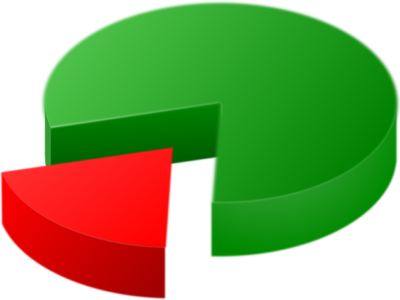Gap Trading Explained. How You Can Benefit From This Regular Market Occurance
Gap trading with a mechanical trading system offers independent traders a relatively easy method to capitalize on sudden market moves. Gaps are often seen in the stock and fund markets. They are somewhat less common in the forex markets, which are usually more liquid and trade overnight and mostly occur at market open on Monday.
[adrotate banner= “65”]
In gap trading stocks, funds, futures and forex, a price “gap” refers to the open space seen on a chart when the price moves sharply up or down with no appreciable trading in between price points.
In its simplest form, gap trading involves buying based on the rise of a gap-up, and selling on the fall of a gap-down. Put differently, gap trading means buying when a price moves beyond the high of the previous time period without trading through that high. Likewise, gap trading means selling/shorting when the price moves below the previous time period’s low without touching it.
I use mechanical trading systems to program my way toward gap trading success by following some basic gap-trading rules and algo trading strategies.
Why do trading gaps occur?
Gaps can occur for a variety of reasons, such as sudden buying or selling pressure, especially by large players. And, they may result from earnings announcements or fundamental news. In fact, gaps can follow any sudden change in investors’ perceptions about a stock, fund, future or currency.
A gap can happen for either fundamental or technical reasons. For example, if a particular company announces higher earnings than expected, its stock price may gap up during the next trading session, if not overnight. Likewise, unfavorable corporate news can spark a gap down.
Or, a stock, fund or future setting a new all-time or long-term high may gap up for technical reasons. That is, a price move past a certain point may trigger institutions’ buying programs, which sense those new highs and spur even more buying.
Likewise, a stock or fund whose price moves below a threshold point may trigger investors’ rush for the exits and thus push its price further downward. Down gaps tend to accelerate more sharply than upward gaps.
And, in the forex markets, any report or other news may greatly widen the bid-ask spread. This creates a tradable gap either up or down.
In any case, you can program a mechanical trading system to recognize and respond profitably for gap trading.
Classification of trading gaps
For study purposes, gaps are usually classified as one of the four types listed below. It’s important to remember that these classifications will only be confirmed in retrospect, after the gap has occurred.
Once I’ve seen the follow-up movement, these labels are useful for categorizing which type of gap has occurred. These classifications help me to better understand how a given stock, fund or currency reacts under certain market conditions.
Fortunately, when using a mechanical trading system for gap trading I don’t need to know what will happen after the gap, only the circumstances which arise just before the gap.
Common gaps are defined as gaps which cannot be otherwise classified in terms of ending one trend and beginning another. They’re very “common,” hence the name. Usually, they’re uneventful and they simply represent an unexplained price gap from one day to the next. The volume during a common gap is often low and this type of gap is generally “filled” quickly. (See below.)
Exhaustion gaps happen at or near the end of a long or strong price run-up or price drop. They signal a final push toward new highs or new lows before the price movement reverses or begins moving sideways. For me, they’re a warning that the recent move is at its end.
Exhaustion gaps are characterized by higher volume and wide price difference between the price at the previous day’s close and the next day’s opening price. Using my gap trading strategies, it’s fairly easy for me to trade and profit from this type of gap. Higher volume is the key to recognizing them.
Continuation gaps can arise in the middle of any price trend. They are sometimes also referred to as “measuring gaps” or “runaway gaps.” Continuation gaps often happen around the midway point of a strong trend.
I interpret them as showing that on a particular day an exceptionally large number of buyers or sellers chose to move into or out of their positions. Perhaps they represent buyers who didn’t get aboard the trend earlier, but who are now piling in.
As well, this type of gap shows higher-than-average volume both during and immediately after the gap. Still, the volume typically isn’t even as high as it would be with an exhaustion gap.
Breakaway gaps occur at the completion of one trend or chart pattern. They mark the start of a new trend. Breakaway gaps offer great gap trading opportunities for me. From a technical viewpoint, they occur when a price manages to break out of its mid-term trading range – say a period of several weeks — or an area of congestion.
A congestion area represents a zone between resistance and support. To break out from a congestion area, a stock, fund, future or currency must receive a significant amount of new buyer interest (on the upside) or negative attention (on the downside).
A true breakaway gap will show a very large increase in volume, whether on the upside or downside. The volume should be larger than with any other type of gap.
In any case, this represents a major turning point in price direction and in my experience the move is likely to continue for the mid-term or long-term.
I account the breakaway point as the new resistance or new support level. With my mechanical gap trading system, I look to harvest substantial gains from this type of breakout.
Most importantly, I avoid falling into the trap of assuming that a breakaway gap will retrace. Once my position is secured, I stay aboard for the ride. I’m confident that the new trend will continue for a reasonable period of time, at least until the next reversal on very high volume.
Gap fills
One other term-of-art often used to describe trading gaps is the word filled. When a gap is “filled,” it means the price has quickly returned to its pre-gap level.
Gap fills typically happen because buyers decide they were over-optimistic or over-pessimistic. Or, the news which triggered the gap is quickly proven false or overblown.
When prices move above or below technical resistance or support levels, I rely on my mechanical gap trading system to determine whether the gap is likely to be filled, and proceed accordingly.
For example, since exhaustion gaps show the end of a trend, they are likely to be filled: The price gaps, then retraces. So, my gap trading system uses data from the previous trend to determine the appropriate entry and exit points to take advantage of both sides of this fairly predictable move.
Gap fading
Gap fading described when a price gap is filled during the same trading period when it occurs. The gap movement “fades away.” It occurs when investors’ exuberance or despair is quickly proven unfounded. This scenario often arises during earnings season.
I and other short-term traders use mechanical gap trading systems to recognize and harvest gains from these quickly-reversed moves in stocks, futures and forex markets.
General gap trading strategies
In markets that I’ve been watching closely, I use several gap trading strategies. In order to profitably trade gaps, I need to keep several things in mind.
First, it’s important to realize that when the price begins to fill its gap, it usually continues until the fill is complete. This is because a gap doesn’t have any nearby support or resistance. Otherwise, that gap wouldn’t have occurred in the first place.
Second, I keep in mind that continuation gaps and exhaustion gaps are predictors of price movements in opposite directions. So, I make sure that my mechanical trading system considers gaps in relation to the recent trend which precedes them. If not, I might trade in the wrong direction.
Also, I ensure that my gap trading system makes decisions based on volume as well as price. To help classify a trading gap for purposes of programming my algo trading system, I make a distinction between high volume, medium volume and low volume.
For a successful breakaway gap, very high volume must be present. And, exhaustion gaps are characterized by somewhat lower volumes, although still higher than usual.
I often watch stocks and funds that trade mostly during daytime sessions. Then, I program my mechanical trading system to buy their shares in after-hours trading when positive earnings are unexpectedly released.
If I’ve done my homework correctly, at the beginning of the next daytime trading session there will usually be a gap up when institutional investors crowd into the stock. As well, I use my mechanical trading system to spot and act on technical factors that signal a likely gap the next day.
This gap trading strategy also works well with currencies. My mechanical trading system tells me whether to buy or sell when a currency gaps up on low liquidity and there is no nearby overhead technical resistance. This works especially well during geopolitical events which seem likely to continue for more than one or two days.
Likewise, I use gap trading tools to profit by fading the gaps in the opposite direction. For example, if the price gaps up based on speculation when there’s nearby resistance, I fade the gap with a short order. So, I ride the price from its failed gap-up level while it goes back down to its normal price range.
Gap trading in the forex markets
The forex markets are open twenty-four hourly except for a weekend closing. So, for charting purposes forex gaps are visible as large candles when the market reopens.
Here’s the gap trading strategy that I use in forex markets. By programming my mechanical trading system with the following basic rules, I’m able to harvest satisfactory gains.
First, the direction of my trade must always be in the same direction as the current hourly price. My mechanical trading system watches for the currency to gap above or below its calculated resistance level according to a thirty-minute price chart.
Next, my system looks for a price retracement back to the calculated resistance or support level. This shows the gap is being filled — The price is returning to its previous resistance-turned-support or support-turned-resistance level.
From a charting perspective, I look for a candle showing price continuation in the same direction as the gap. My gap trading system takes this as a confirmation of continuing support or resistance at the indicated level, and trades accordingly.
Double check volume before trading
With help from my mechanical trading system including the appropriate algorithms, I’ve been enjoying good results in trading gaps in the prices of stocks, ETFs, futures and currencies.
I’ve found that volume is the most important qualification when determining the type of gap and assessing the likelihood that the price move will continue.
To avoid becoming emotionally caught up in any price move, I rely on my gap trading system to quantify and verify the volume before sending any buy or sell orders. I set my algo trading parameters to check a variety of pricing sources before generating orders.
If my mechanical trading tools detect high-volume resistance that is preventing the marketplace from filling a gap, then my system double checks the volume and price data to ensure that my trading premise is correct before proceeding.
Of course, I always program my gap trading system with appropriate stop-loss orders. Some traders believe that gap trading is risky. Yet, with the right mechanical trading tools it offers plenty of opportunities for fat gains.
In fact, gap trading by using mechanical trading systems is currently a hot topic: A book regarding ETF gap trading has recently been published, and there are many academic reports and quant-focused articles about how to trade gaps.
I recommend that you explore the possibilities of gap trading with a good mechanical trading system. With the right tools, gap trading can be both predictable and profitable.
Source: Gap Trading Made Easy
[adrotate banner= “70”]














